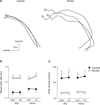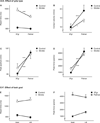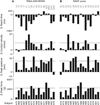Grip type and task goal modify reach-to-grasp performance in post-stroke hemiparesis
- PMID: 22357103
- PMCID: PMC3358536
- DOI: 10.1123/mcj.16.2.245
Grip type and task goal modify reach-to-grasp performance in post-stroke hemiparesis
Abstract
This study investigated whether grip type and/or task goal influenced reaching and grasping performance in poststroke hemiparesis. Sixteen adults with poststroke hemiparesis and twelve healthy adults reached to and grasped a cylindrical object using one of two grip types (3-finger or palmar) to achieve one of two task goals (hold or lift). Performance of the stroke group was characteristic of hemiparetic limb movement during reach-to-grasp, with more curved handpaths and slower velocities compared with the control group. These effects were present regardless of grip type or task goal. Other measures of reaching (reach time and reach velocity at object contact) and grasping (peak thumb-index finger aperture during the reach and peak grip force during the grasp) were differentially affected by grip type, task goal, or both, despite the presence of hemiparesis, providing new evidence that changes in motor patterns after stroke may occur to compensate for stroke-related motor impairment.
Figures




Similar articles
-
Need for speed: better movement quality during faster task performance after stroke.Neurorehabil Neural Repair. 2012 May;26(4):362-73. doi: 10.1177/1545968311425926. Epub 2011 Dec 2. Neurorehabil Neural Repair. 2012. PMID: 22140198 Free PMC article.
-
Palmar arch modulation in patients with hemiparesis after a stroke.Exp Brain Res. 2009 Oct;199(1):59-70. doi: 10.1007/s00221-009-1972-5. Epub 2009 Aug 19. Exp Brain Res. 2009. PMID: 19690845
-
Deficits in grasp versus reach during acute hemiparesis.Exp Brain Res. 2005 Sep;166(1):126-36. doi: 10.1007/s00221-005-2350-6. Epub 2005 Jul 14. Exp Brain Res. 2005. PMID: 16021431
-
Compensation for distal impairments of grasping in adults with hemiparesis.Exp Brain Res. 2004 Jul;157(2):162-73. doi: 10.1007/s00221-004-1829-x. Epub 2004 Feb 19. Exp Brain Res. 2004. PMID: 14985899
-
Neuroscience findings on coordination of reaching to grasp an object: implications for research.Neurorehabil Neural Repair. 2013 Sep;27(7):622-35. doi: 10.1177/1545968313483578. Epub 2013 Apr 8. Neurorehabil Neural Repair. 2013. PMID: 23569173 Review.
Cited by
-
Motor compensation and its effects on neural reorganization after stroke.Nat Rev Neurosci. 2017 May;18(5):267-280. doi: 10.1038/nrn.2017.26. Epub 2017 Mar 23. Nat Rev Neurosci. 2017. PMID: 28331232 Free PMC article. Review.
-
The effects of an object's height and weight on force calibration and kinematics when post-stroke and healthy individuals reach and grasp.Sci Rep. 2021 Oct 18;11(1):20559. doi: 10.1038/s41598-021-00036-9. Sci Rep. 2021. PMID: 34663848 Free PMC article.
-
Characterization of normative hand movements during two functional upper limb tasks.PLoS One. 2018 Jun 21;13(6):e0199549. doi: 10.1371/journal.pone.0199549. eCollection 2018. PLoS One. 2018. PMID: 29928022 Free PMC article.
-
Neurostimulation and Reach-to-Grasp Function Recovery Following Acquired Brain Injury: Insight From Pre-clinical Rodent Models and Human Applications.Front Neurol. 2020 Jul 21;11:835. doi: 10.3389/fneur.2020.00835. eCollection 2020. Front Neurol. 2020. PMID: 32849253 Free PMC article. Review.
-
Targeted Engagement of the Action Selection Network during Task-Oriented Arm Training after Stroke.Neural Plast. 2020 Sep 23;2020:8814158. doi: 10.1155/2020/8814158. eCollection 2020. Neural Plast. 2020. PMID: 33029117 Free PMC article.
References
-
- Andrews AW, Thomas MW, Bohannon RW. Normative values for isometric muscle force measurements obtained with hand-held dynamometers. Phys Ther. 1996;76(3):248–259. - PubMed
-
- Ansuini C, Giosa L, Turella L, Altoe G, Castiello U. An object for an action, the same object for other actions: effects on hand shaping. Exp Brain Res. 2008;185(1):111–119. - PubMed
-
- Archambault P, Pigeon P, Feldman AG, Levin MF. Recruitment and sequencing of different degrees of freedom during pointing movements involving the trunk in healthy and hemiparetic subjects. Exp Brain Res. 1999;126(1):55–67. - PubMed
-
- Bastian AJ, Martin TA, Keating JG, Thach WT. Cerebellar ataxia: abnormal control of interaction torques across multiple joints. J Neurophysiol. 1996;76(1):492–509. - PubMed
Publication types
MeSH terms
Grants and funding
LinkOut - more resources
Full Text Sources
Medical

